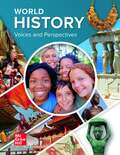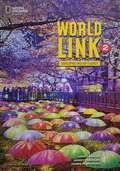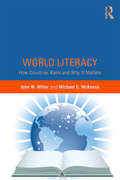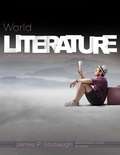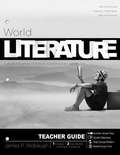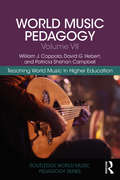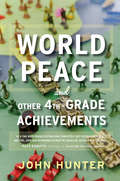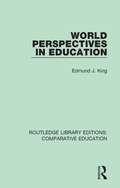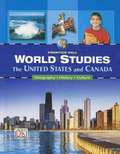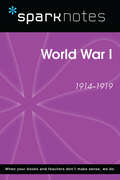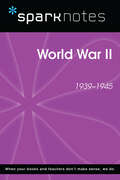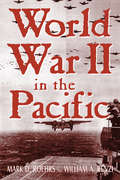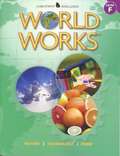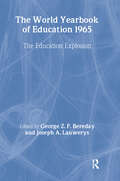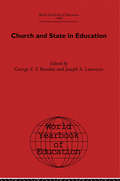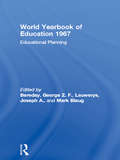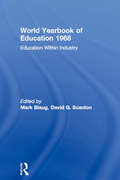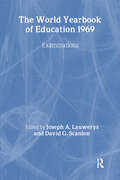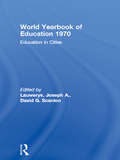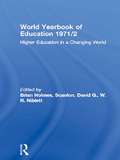- Table View
- List View
World History: Prehistoric Times to the Present
by Diane HartWorld history is the story of many lands and peoples. It is an exciting story filled with remarkable men and women, amazing discoveries, and great adventures. It is also often a tragic story of war, hunger, and human suffering.
World History: Voices and Perspectives
by Spielvogel Jackson J.Students can explore history through an abundance of primary and secondary sources showcasing multiple perspectives, investigate Essential Questions, and make vital connections between the past and present. <p><p>Compelling questions for each topic that encourage deep thought and reflection.
World Language Education as Critical Pedagogy: The Promise of Social Justice
by Timothy G. Reagan Terry A. OsbornAccessible and cutting-edge, this text is a pivotal update to the field and offers a much-needed critical perspective on world language education. Building off their classic 2002 book, The Foreign Language Educator in Society, Timothy G. Reagan and Terry A. Osborn address major issues facing the world language educator today, including language myths, advocacy, the perceived and real benefits of language learning, linguistic human rights, constructivism, learning theories, language standards, monolingualism, bilingualism and multiculturalism. Organized into three parts – "Knowing Language," "Learning Language," and "Teaching Language" – this book applies a critical take on conventional wisdom on language education, evaluates social and political realities, assumptions, and controversies in the field. Each chapter includes questions for reflection and discussion to support students and educators in developing their own perspectives on teaching and learning languages. With a critical pedagogy and social justice lens, this book is ideal for scholars and students in foreign/world language education, social justice education, and language teaching methodology courses, as well as pre- and in-service teachers.
World Link 2
by Nancy Douglas John Hughes James R. MorganWorld Link, Fourth Edition teaches learners to communicate confidently. It develops integrated language skills with an emphasis on spoken English through familiar topics, relevant grammar, and essential vocabulary. World Link brings the world to the classroom through a famously fun video program, relatable National Geographic content, and teacher-tested lessons.
World Literacy: How Countries Rank and Why It Matters
by Michael C. McKenna John W. MillerInternational literacy assessments have provided ample data for ranking nations, charting growth, and casting blame. Summarizing the findings of these assessments, which afford a useful vantage from which to view world literacy as it evolves, this book examines literate behavior worldwide, in terms of both the ability of populations from a wide variety of nations to read and the practice of literate behavior in those nations. Drawing on The World’s Most Literate Nations, author Jack Miller’s internationally released study, emerging trends in world literacy and their relationships to political, economic, and social factors are explored. Literacy, and in particular the practice of literate behaviors, is used as a lens through which to view countries’ economic development, gender equality, resource utilization, and ethnic discrimination. Above all, this book is about trajectories. It begins with historical contexts, described in terms of support for literate cultures. Based on a variety of data sources, these trends are traced to the present and then projected ahead. The literate futures of nations are discussed and how these relate to their economic and sociocultural development. This book is unique in providing a broader perspective on an intractable problem, a vantage point that offers useful insights to inform policy, and in bringing together an array of relevant data sources not typically associated with literacy status.
World Literature, Fifth Edition
by ChapmanThis beautifully illustrated anthology includes twelve units representing writers from around the world. Built-in studies of historical and cultural backgrounds enable students to understand the literature. Students will practice interpreting literature through a biblical lens. Critical thinking skills are built through answering thought-provoking responses worldview and literature-related questions. Students will also practice interpreting symbols and themes in visual art with a Spotlight on Visual Literacy feature. Poetry memorization continues in this grade. Students are also encouraged to memorize select poems.
World Literature-Student
by James P. StobaughEnjoy beloved classics while developing vocabulary, reading, and critical thinking skills! Each literature book in the series is a one-year course Each chapter has five lessons with daily concept-building exercises, warm-up questions, and guided readings Easy-to-use with suggested reading schedules and daily calendar Equips students to think critically about philosophy and trends in culture, and articulate their views through writing A well-crafted presentation of whole-book or whole-work selections from the major genres of classic literature (prose, poetry, and drama), each course has 34 chapters representing 34 weeks of study, with an overview of narrative background material on the writers, their historical settings, and worldview. The rich curriculum's content is infused with critical thinking skills, and an easy-to-use teacher's guide outlines student objectives with each chapter, providing the answers to the assignments and weekly exercises. The final lesson of the week includes both the exam, covering insights on the week's chapter, as well as essays developed through the course of that week's study, chosen by the educator and student to personalize the coursework for the individual learner.
World Literature-Teacher
by James P. StobaughEnjoy beloved classics while developing vocabulary, reading, and critical thinking skills! Each literature book in the series is a one-year course Each chapter has five lessons with daily concept-building exercises, warm-up questions, and guided readings Easy-to-use with suggested reading schedules and daily calendar Equips students to think critically about philosophy and trends in culture, and articulate their views through writing A well-crafted presentation of whole-book or whole-work selections from the major genres of classic literature (prose, poetry, and drama), each course has 34 chapters representing 34 weeks of study, with an overview of narrative background material on the writers, their historical settings, and worldview. The rich curriculum's content is infused with critical thinking skills, and an easy-to-use teacher's guide outlines student objectives with each chapter, providing the answers to the assignments and weekly exercises. The final lesson of the week includes both the exam, covering insights on the week's chapter, as well as essays developed through the course of that week's study, chosen by the educator and student to personalize the coursework for the individual learner.
World Music Pedagogy, Volume VII: Teaching World Music in Higher Education (Routledge World Music Pedagogy Series)
by Patricia Shehan Campbell David G. Hebert William J. CoppolaWorld Music Pedagogy, Volume VII: Teaching World Music in Higher Education addresses a pedagogical pathway of varied strategies for teaching world music in higher education, offering concrete means for diversifying undergraduate studies through world music culture courses. While the first six volumes in this series have detailed theoretical and applied principles of World Music Pedagogy within K-12 public schools and broader communities, this seventh volume is chiefly concerned with infusing culture-rich musical experiences through world music courses at the tertiary level, presenting a compelling argument for the growing need for such perspectives and approaches. These chapters include discussions of the logical trajectories of the framework into world music courses, through which the authors seek to challenge the status quo of lecture-only academic courses in some college and university music programs. Unique to this series, each of these chapters illustrates practical procedures for incorporating the WMP framework into sample classes. However, this volume (like the rest of the series) is not a prescriptive "recipe book" of lesson plans. Rather, it seeks to enrich the conversation surrounding cultural diversity in music through philosophically-rooted, social justice-conscious, and practice-oriented perspectives.
World Music Pedagogy, Volume VII: Teaching World Music in Higher Education (Routledge World Music Pedagogy Series)
by Patricia Shehan Campbell David G. Hebert William J. CoppolaWorld Music Pedagogy, Volume VII: Teaching World Music in Higher Education addresses a pedagogical pathway of varied strategies for teaching world music in higher education, offering concrete means for diversifying undergraduate studies through world music culture courses. While the first six volumes in this series have detailed theoretical and applied principles of World Music Pedagogy within K-12 public schools and broader communities, this seventh volume is chiefly concerned with infusing culture-rich musical experiences through world music courses at the tertiary level, presenting a compelling argument for the growing need for such perspectives and approaches.These chapters include discussions of the logical trajectories of the framework into world music courses, through which the authors seek to challenge the status quo of lecture-only academic courses in some college and university music programs. Unique to this series, each of these chapters illustrates practical procedures for incorporating the WMP framework into sample classes. However, this volume (like the rest of the series) is not a prescriptive "recipe book" of lesson plans. Rather, it seeks to enrich the conversation surrounding cultural diversity in music through philosophically-rooted, social justice-conscious, and practice-oriented perspectives.
World Peace and Other 4th-Grade Achievements
by John Hunter&“His ideas will help anyone who has the courage to understand that a real education must go beyond filling in circles on a standardized test form.&” —Rafe Esquith, New York Times-bestselling author of Teach Like Your Hair&’s on Fire Can playing a game lead to world peace? If it&’s John Hunter&’s World Peace Game, it just might. In Hunter&’s classroom, students take on the roles of presidents, tribal leaders, diplomats, and military commanders. Through battles and negotiations, standoffs and summits, they strive to resolve a sequence of many-layered, interconnected scenarios, from nuclear proliferation to tribal warfare. Now, Hunter shares inspiring stories from over thirty years of teaching the World Peace Game, revealing the principles of successful collaboration that people of any age can apply. He offers not only a forward-thinking report from the frontlines of American education, but also a generous blueprint for a world that bends toward cooperation rather than conflict. In this deeply hopeful book, a visionary educator shows us what the future of education can be. &“The World Peace Game devised by fourth-grade teacher Hunter has spread from a classroom in 1978 to a documentary, a TED Talk, the Pentagon, and now finally a book, in which he describes the ways his students have solved political and ecological crises that still loom large in the world of adults . . . Hunter&’s optimism is infectious.&” —Publishers Weekly &“Inspired, breath-of-fresh-air reading.&” — Kirkus Reviews &“Hunter proves the value of &‘slow teaching&’ in this important, fascinating, highly readable resource for educators and parents alike.&” — Booklist
World Perspectives in Education (Routledge Library Editions: Comparative Education #9)
by Edmund J. KingOriginally published in 1962. In this book the main problems of contemporary education are illustrated with fresh material from many countries and assessed in a context of rapid change in technology, society, and politics. Familiar educational concerns are carefully considered; but the altered status of schools, teachers and homes in relation to competing influences receives particular attention. Recent reforms in the Soviet Union, and the development of education in Asia and Africa, are assessed vis-a-vis topical questions and proposals in Great Britain, the United States, and several Western European countries. The book is therefore useful both for ‘problem' studies in comparative education, and for an up-to-date review of principles and practices in a critically formative period. It is also intended to present a study of education that will be widely educative and contribute to world understanding.
World Regional Geography
by Caitlin FinlaysonWorld Regional Geography by Finlayson provides a concise and accessible introduction to the major concepts in Geography through an exploration of the world's regions. This innovative textbook, which has been downloaded over 15,000 times in more than 30 countries, approaches geography as experts understand the discipline, focusing on connections between places and an in-depth understanding of core themes. This thematic approach provides students with an introduction to thinking geographically and an in-depth understanding of the geography of our world. Table of Contents: 1. Introduction 2. Europe 3. Russia 4. North America 5. Middle and South America 6. Sub-Saharan Africa 7. North Africa and Southwest Asia 8. South Asia 9. East and Southeast Asia 10. Oceania
World War I (SparkNotes History Notes)
by SparkNotesWorld War I (SparkNotes History Note) Making the reading experience fun! SparkNotes History Guides help students strengthen their grasp of history by focusing on individual eras or episodes in U.S. or world history. Breaking history up into digestible lessons, the History Guides make it easier for students to see how events, figures, movements, and trends interrelate. SparkNotes History Guides are perfect for high school and college history classes, for students studying for History AP Test or SAT Subject Tests, and simply as general reference tools.Each note contains a general overview of historical context, a concise summary of events, lists of key people and terms, in-depth summary and analysis with timelines, study questions and suggested essay topics, and a 50-question review quiz.
World War II (SparkNotes History Notes)
by SparkNotesWorld War II (SparkNotes History Note) Making the reading experience fun! SparkNotes History Guides help students strengthen their grasp of history by focusing on individual eras or episodes in U.S. or world history. Breaking history up into digestible lessons, the History Guides make it easier for students to see how events, figures, movements, and trends interrelate. SparkNotes History Guides are perfect for high school and college history classes, for students studying for History AP Test or SAT Subject Tests, and simply as general reference tools.Each note contains a general overview of historical context, a concise summary of events, lists of key people and terms, in-depth summary and analysis with timelines, study questions and suggested essay topics, and a 50-question review quiz.
World War II in the Pacific: History Of World War Ii In The Pacific
by William A. Renzi Mark D. RoehrsWorld War II laid the groundwork for much of the international system that exists today, especially in the Pacific Rim. This brief but comprehensive survey of the War in the Pacific incorporates both United States and Japanese perspectives, providing a global approach to the Asian theater of the conflict. Drawing on decades of new scholarship and written in an engaging, narrative style, this book traces United States-Japanese relations from the late nineteenth century to the war's end in 1945. It covers every aspect of the war, and gives special attention to ongoing historical debates over key issues. The book also provides new details of many facets of the conflict, including expansionism during the 1930s, events and policies leading up to the war, the importance of air power and ground warfare, military planning and strategic goals, the internment of Japanese-Americans in the U.S., Allied plans and disputes over Russian participation, the decision to drop the atomic bomb, and conditions for surrender.
World Works, Level F: Nature, Technology, Food
by McGraw-HillExplore how things work through high-interest, engaging informational nonfiction!Improve reading comprehension of informational nonfiction, encourage student inquiry with high-interest topics, and prepare students for high-stakes assessments with the World WorksTM series from Jamestown Education. World WorksTM brings the world to life. Each four-color, consumable book of the 6-book series features 9 informational articles focused on how things work. Each unit within a book covers one of the following topics; Everyday Things, Law, Health, Food, Technology, or Nature. All categories are covered at each reading level. Each article answers the question, "How Does it Work?" Each informational article includes a graph, chart, or diagram, along with an after-reading critical-thinking questions on interpreting charts and graphs.
World Yearbook of Education 1965: The Education Explosion (World Yearbook of Education)
by George Z. F. Bereday Joseph A. LauwerysPublished almost every year since its beginnings four decades ago, The World Yearbook of Education has become one of the most established and respected international publications in education. Each edition focuses on a particular key issue and includes contributions from leading scholars. Now reprinted for 2006, all these classic references have become available to buy again.
World Yearbook of Education 1966: Church and State in Education (World Yearbook of Education)
by George Z. F. Bereday Joseph A. LauwerysFirst published in 2005. Broadly speaking, church-state relations in education turn nowadays upon two chief issues: I. Should religion be taught in state schools? And if so, may the state interfere with the teaching? 2. In countries where separate schools, under church control, exist should they have a share of public funds? Church and state issues flare up anew whenever there appears a repressive government action or a dynamic drive of the churches for a larger share of privileges. Both occur frequently enough to make this World Year Book a lively read.
World Yearbook of Education 1967: Educational Planning (World Yearbook of Education)
by Mark Blaug George Z. F. Bereday Joseph A. LauwerysFirst published in 2005. By focusing on planning this Year Book follows a tradition well established in Comparative Education. This year book hopes that by drawing together into one volume contributions from many distinguished specialists, it hopes to help in the necessary organization and systematization of a field which is full of promise.
World Yearbook of Education 1968: Education Within Industry (World Yearbook of Education)
by Joseph A. Lauwerys David G. Scanlon"First Published in 2005, Routledge is an imprint of Taylor & Francis, an informa company."
World Yearbook of Education 1969: Examinations (World Yearbook of Education)
by Joseph A. Lauwerys and David G. ScanlonFirst Published in 2005. Almost everywhere policies designed to broaden access to education and to promote equality of opportunity are now pursued. In consequence the importance of examinations grows, since success in them determines entry to higher education and thus to professional posts. They are therefore a major instrument of social mobility and promotion which affects social structure by applying criteria of selection nearly always accepted unconsciously and uncritically. The aim of this text in selecting Examinations as the theme of the 1969 WORLD YEAR BOOK, was to present a comparative analysis of the way in which examinations are devised, administered and assessed, to find out why we are examining, and to look at the ways in which we examine to see if these are efficient, relevant and reliable.
World Yearbook of Education 1970: Education in Cities (World Yearbook of Education)
by Joseph A. Lauwerys David G. Scanlon"First Published in 2005, Routledge is an imprint of Taylor & Francis, an informa company."
World Yearbook of Education 1971/2: Higher Education in a Changing World (World Yearbook of Education)
by W. R. Niblett Brian Holmes David G. ScanlonPublished in the year 2005, the World Yearbook of Education 1971/2 is a valuable contribution to the field of Major Works.

